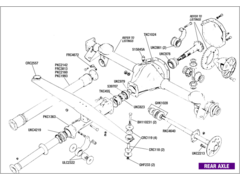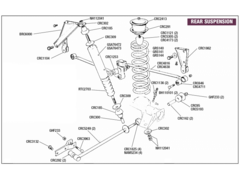britishtrident
|
| posted on 15/10/05 at 02:32 PM |

|
|
quote:
Originally posted by MikeRJ
Hmm, all this work...and it's still a live axle. Effort better expended on a good IRS design IMO.
Didn't Lotus have a series of axle housing failures with their original three link design? Forces from accelerating and braking put torsional
forces through the axle tubes which aren't there with a 4 link setup.
Lotus & Caterham were prone to tearing the mounts out the rear axle case -- the actual torsional forces on axle aren't less than in the
Locost aranagement but on the 5 link Locost system are fed into the axle in a more sensible way. The Problem with the arangement on the early 7 and
Mk1 Lotus Cortina was the loads were being fed in to one point on a paper thin axle casing.
As I think somebody else in the thread has pointed out you can get the same roll centre location by using 4 links with angled lower links --- think
Cortina Mk3+ axle turned
upside down.
[Edited on 15/10/05 by britishtrident]
|
|
|
|
|
gazza285
|
| posted on 15/10/05 at 03:59 PM |

|
|
quote:
Originally posted by cymtriks
quote:
Originally posted by gazza285
Different angle.

It doesn't work correctly. The fixed arm means the axle will just pivot around the front mount and put unnecessary loads on the pinion and
propshaft.
Not quite!
The central arm has a floating link at the front so it cannot locate the axle fore-aft.
What it does do is to stop the axle from rotating. The two trailing links provide fore-aft location, a third, or fourth trailing link to prevent the
axle from rotating isn't needed as this movement is prevented by the third central link.
The complete set up goes like this:
Translation:
fore-aft by the two side links
sideways by the Watts linkage
vertical by the springs
Rotation:
About car centre line by the springs
About Axle centre line by the trailing link and the central floating link
About the vertical by the trailing links
That's all six taken care of and not conflicting so it does work!
Having said that how many links are there?
2 pushrods
2 bell cranks
2 trailing links
2 lateral links
1 Watts link centre
1 trailing arm
1 trailing arm vertical support at the front
That's 11 links!
What on Earth's wrong with a Satchell link? Just four links, two upper trailing and two lower angled from the ends of the axles to the back of
the transmission tunnel. All for links being rubber bushed or spherical jointed. Simple. Cheap. Works well.
Explain to me how it keeps the axle from rotating. When you move the axle up or down this arm is fixed to the axle casing and moves up and down
accordingly. The vertical movement is prevented at the front by the link arrangement so if the axle moves up and down it must also be rotating around
the front mount.Yes it is preventing the axle twisting under drive and braking but it is forcing the axle to rotate under bump.
DO NOT PUT ON KNOB OR BOLLOCKS!
|
|
|
cymtriks
|
| posted on 16/10/05 at 07:11 AM |

|
|
I ment that it prevents free rotation.
The central link could be described as a torque reation link, it transmits no fore-aft loads at all but is loaded in bending as it as it takes up the
torque reaction.
I still reckon Satchel link would be better though it would be hard to get the right angles for the lower tubes in the available space. Perhaps an
axle mount swept back from the axle centre line would be needed, or a stronger lower tube, say 1/8 wall thickness.
Has anyone tried a Satchel link?
|
|
|
Dale
|
| posted on 16/10/05 at 02:55 PM |

|
|
On the mumford pic shown. Am I correct in that the roll center is the joing point of the 2 long arms if their lines where extened to meet in the
middle.?
Dale
Thanks
Dale
my 14 and11 year old boys 22
and 19 now want to drive but have to be 25 before insurance will allow. Finally on the road
|
|
|
Syd Bridge
|
| posted on 16/10/05 at 04:26 PM |

|
|
quote:
Originally posted by britishtrident
Actually in the real world nearly all Watts linkages have the crank mounted on the axle,
[Edited on 15/10/05 by britishtrident]
What's cheap to build on a production line is not necessarily ideal for a racecar. (Otherwise we would all still be driving rwd front engined
cars.)
Haven't lately looked under the rear of an Aussie V8 racecar, and more than a few nascar type things, have you? 
And the Ford rally cars that used to have solid axles used the system I mentioned above, contrary to what you may think. I built enough of the
things!!
Then again, you still believe in 'roll centres'  Not all that that's put in print is current, nor backed up by scientific fact. Not all that that's put in print is current, nor backed up by scientific fact.
[Edited on 16/10/05 by Syd Bridge]
|
|
|
Dale
|
| posted on 16/10/05 at 04:45 PM |

|
|
I see a thousand watts links bolted to the diff every day- crown vic police crusiers- but I believe it is done that way as its probably a couple of
seconds faster to put in and does not require a center section in the frame to bolt the section to.
You would be suprised as to how well the big car handles its 4 link live axle same as the locost with a coil over spring type of rear -or air bag.
and unequal length A arms on the front.
Dale
Thanks
Dale
my 14 and11 year old boys 22
and 19 now want to drive but have to be 25 before insurance will allow. Finally on the road
|
|
|
Bob C
|
| posted on 17/10/05 at 09:10 AM |

|
|
So - has anyone driven a powerful car with this kind of "torque tube" wheel torque reaction control? By my reckoning the wheel torque
reaction will try to compress the springs leading to extra "squat". Does the extra squat lead to extra wheelspin?
cheers
Bob
|
|
|
britishtrident
|
| posted on 17/10/05 at 01:05 PM |

|
|
Rover used a torque tube on the Sd1 including the racers, Opel at one time used right across the range including the Comodore racers.
I think also the Chevette HSR 2300 might have used a torque tube but can't be sure.
|
|
|
britishtrident
|
| posted on 17/10/05 at 01:11 PM |

|
|
rover sd1
 
Rescued attachment ld35a.gif
|
|
|
britishtrident
|
| posted on 17/10/05 at 01:15 PM |

|
|
sd1
 
Rescued attachment ld386a.gif
|
|
|













